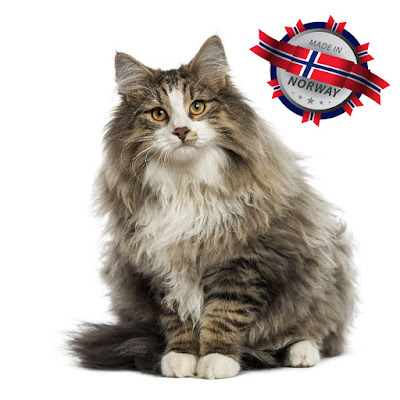 The Norwegian Forest Cat is a cat after my own heart because
it has been around for a long time and has appeared in the mythology of its
country of origin. Obviously I am speaking of Norway, and the mythology is
Norse. But I am getting ahead of myself. Let’s meet the cat first.
The Norwegian Forest Cat is a cat after my own heart because
it has been around for a long time and has appeared in the mythology of its
country of origin. Obviously I am speaking of Norway, and the mythology is
Norse. But I am getting ahead of myself. Let’s meet the cat first.
A sturdy, affectionate, and gregarious breed
 |
| Norwegian Forest Cats, or Wegies, are well adapted to cold weather.
Photo by Pieter Lanser [CC-BY-2.0],
via Wikimedia Commons.
|
Norwegian Forest Cats are slow to mature, only reaching full
size at about 5 years old. For females, “full size” is typically 9–12 pounds;
for males, 12–16 pounds. They don’t need as much grooming as you might expect (a once-a-week brushing is usually enough),
though they do shed their winter coat in the spring, so more grooming is needed at that time (the Cat Fanciers’ Association describes
this as the “annual molt”). Wegies like to be with people and are good with children.
In the wild, they spend a lot of time up in trees, so they would like to have something
nice and tall to climb on at home.
And now, the history and mythology
 |
The Norse goddess Freya in her chariot pulled by two
blue cats. They don't look much like Skogkatt here,
but that is what they are believed to represent.
© Patrimonio | Dreamstime.com - FreyaNorse Goddess Photo |
Norse mythology has several references to large cats that we think must by Skogkatt. For example, the Prose Edda (ca. 1179–1241) mentions that the goddess Freya has two large cats that pull her chariot (these cats happen to be blue; see our post “The Goddess Freya’s Cats” for more). Another story features a cat so huge, even the great god Thor could not lift it. Cats were important in Norse culture and were often given to young women as wedding gifts, presumably because of their association with Freya, the fertility goddess.
 |
| Norwegian Forest Cats love to climb! If you get one, you must provide climbing opportunities. Photo via Adobe Stock. |
The modern history of the Norwegian Forest Cat
In 1938, a Wegie made the breed’s first appearance at a cat
show, in Oslo. World War II interrupted the breed’s development though, and it
was the 1970s before a standard was described and a breeding program began. In
1973, two purebred Wegies, named Pippa Skogpuss and Pans Truls, were bred and
had two kittens. Pans Truls would later be recognized as THE Skogkatt—the
standard by which all others would be judged.
The first Norwegian Forest Cats to officially reach the
United States arrived in 1979 (although they may have reached North American
shores much earlier, in the late 10th century with the explorer Leif Erikson [d.
1020]). They reached the United Kingdom a few years later, in 1986.
Learn more!
We've written about the Skogkatt before, in the posts "What Kind of Cat Would Santa Claus Have: Part 1" and "Did Vikings Have Cats?"
Sources
"About the Norwegian Forest Cat." The Cat Fanciers' Association website. http://cfa.org/Breeds/BreedsKthruR/NorwegianForestCat.aspx.
Pickeral, Tamsin. "Norwegian Forest Cat." The Elegance of the Cat: An Illustrated History. Hauppauge, NY: Barron's, 2013.
(Top illustration created with Adobe Stock images.)
[1]
The Norwegian Forest Cat is also called an NFC, but “wegie” sounds more like a
friendly name and less like a government agency, so we will go with that.

they are such exquisite cats and they are so big!!! Love them! catchatwithcarenandcody
ReplyDeleteIs that pronounced 'wee-gee' or 'wedg-ee'? Beautiful cats!
ReplyDeleteSuch gorgeous cats. Have you checked out Edith Maxwell's Local Foods mystery series? It stars a Norwegian Forest Cat.
ReplyDeleteI have seen Norwegian Forst cats at TICA cat shows - they are really beautiful!
ReplyDeleteVery interesting post. They are beautiful cats.
ReplyDeleteThis is a gorgeous cat breed. We had a cat once that we are sure was part NF Cat, he had a gorgeous tail with hair almost 10 inches long, tufts out his feet an inch long & fur out his ears as well along with a fabulous mane.
ReplyDelete